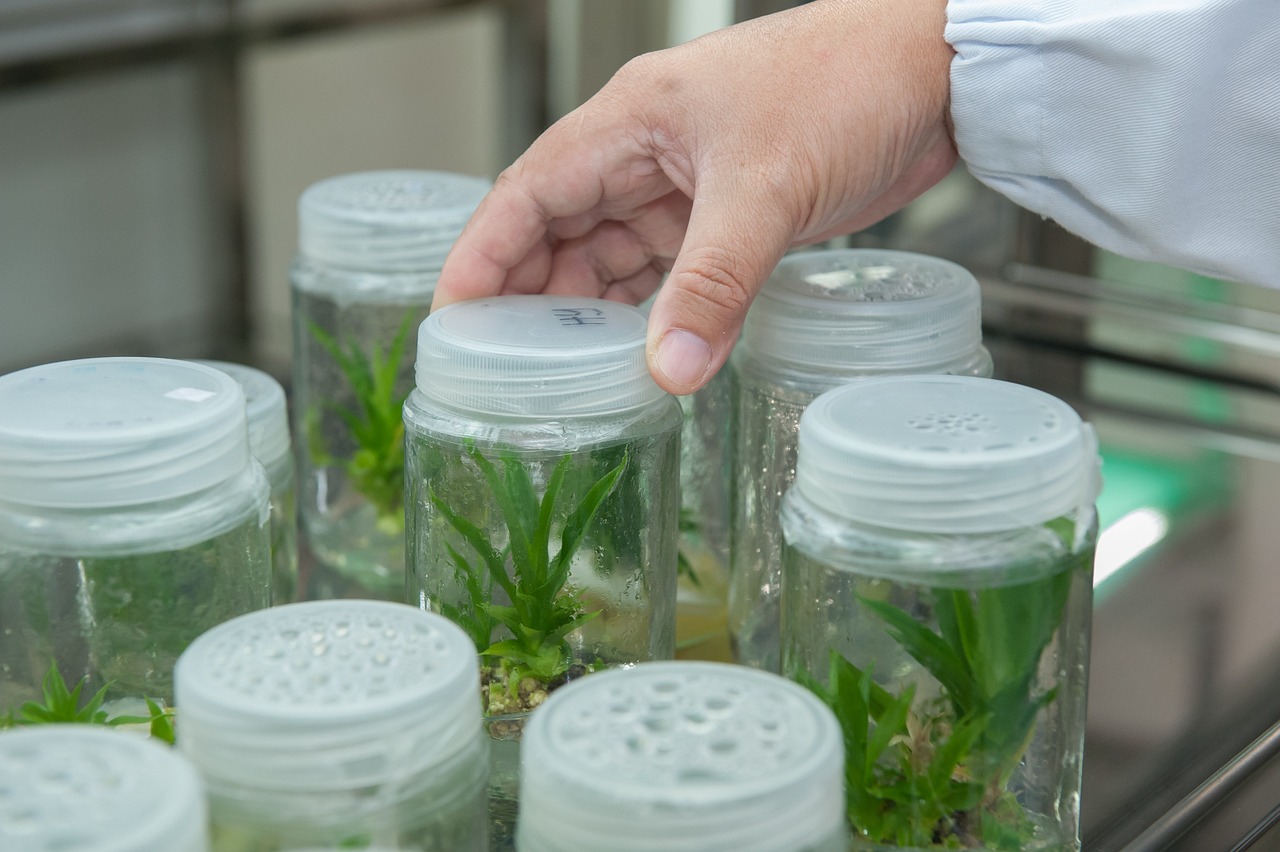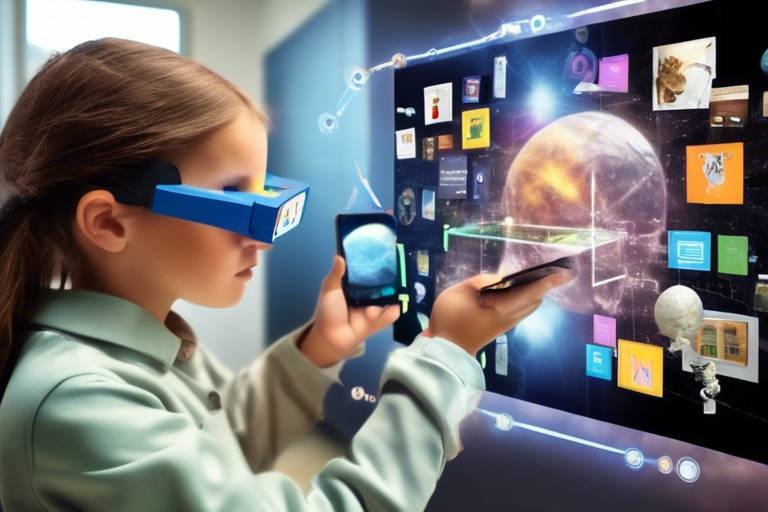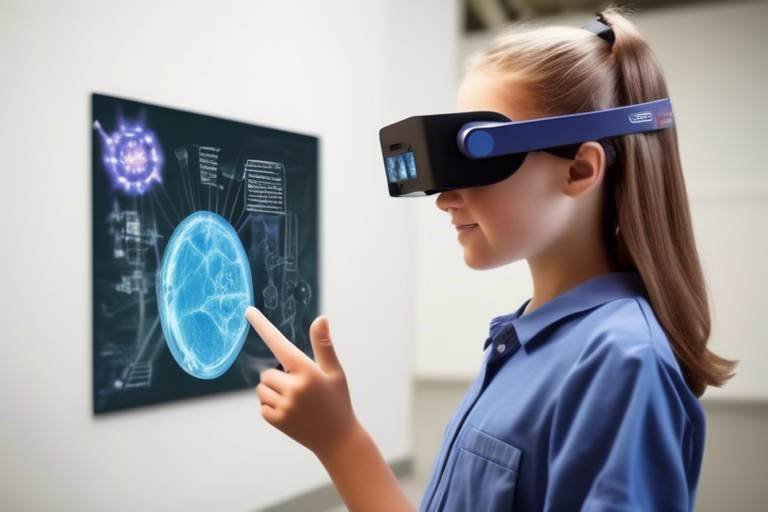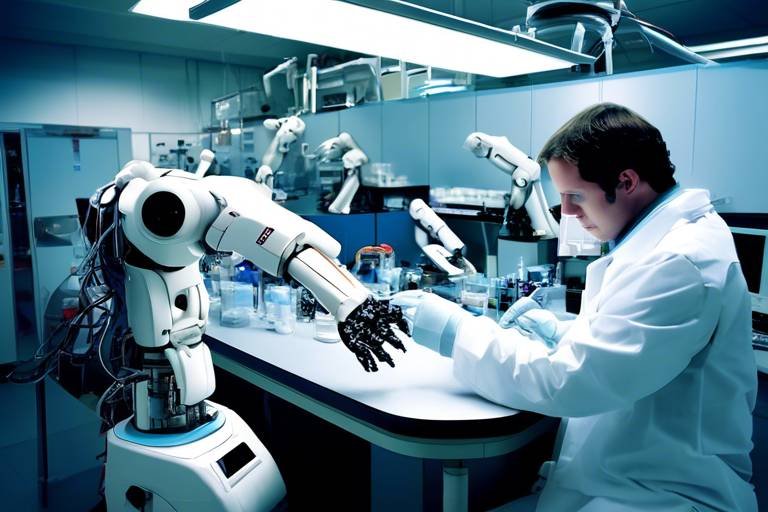How Technology is Enhancing Pharmaceutical Research
The landscape of pharmaceutical research is undergoing a remarkable transformation, largely driven by the rapid advancements in technology. Today, researchers are equipped with cutting-edge tools that not only streamline the drug discovery process but also enhance the overall efficiency of clinical trials and data management. Imagine a world where the painstaking work of sifting through mountains of data is replaced by intelligent algorithms that can predict outcomes with astonishing accuracy. This is not just a dream; it's the reality of modern pharmaceutical research.
At the heart of this transformation is the integration of artificial intelligence and big data analytics. These technologies are reshaping how researchers approach drug discovery, allowing them to identify potential candidates faster and more accurately than ever before. Gone are the days when researchers relied solely on traditional methods that were often slow and cumbersome. Now, they can leverage vast datasets and sophisticated algorithms to uncover insights that were previously hidden, paving the way for new and innovative treatments.
Moreover, the utilization of patient data is revolutionizing the understanding of drug efficacy and safety. By analyzing real-world evidence derived from patient experiences, researchers can gain invaluable insights into how drugs perform outside of controlled environments. This not only informs regulatory decisions but also enhances treatment strategies, ensuring that they are tailored to meet the unique needs of individual patients. Think of it as customizing a meal to suit your taste; personalized medicine is all about creating the right treatment for the right person.
However, with great power comes great responsibility. The ethical considerations surrounding data privacy cannot be overlooked. As researchers dive deeper into patient data, they must navigate the complexities of ensuring robust security measures and compliance with regulations. This is a crucial aspect of maintaining trust between patients and researchers, as any breach of confidentiality could have dire consequences.
In addition to AI and data analytics, machine learning is playing a pivotal role in streamlining pharmaceutical research processes. By optimizing clinical trials and enhancing predictive modeling, machine learning significantly reduces the time and costs associated with drug development. Imagine being able to forecast outcomes with pinpoint accuracy; that’s the promise of machine learning in the pharmaceutical sector.
Another groundbreaking technology making waves in clinical trials is virtual reality (VR). This immersive technology is not just for gaming; it's being used to engage patients, train researchers, and collect data in ways that were previously unimaginable. Picture a researcher donning a VR headset to simulate complex clinical trial protocols; this hands-on experience can lead to a deeper understanding and improved execution of trials.
Furthermore, innovative patient recruitment strategies leveraging VR are enhancing enrollment rates and ensuring diverse representation in clinical studies. By creating engaging and interactive environments, researchers can attract a wider range of participants, which is vital for the validity of clinical trials. This approach is akin to casting a wide net to catch a diverse catch, ensuring that the research reflects the population it aims to serve.
Lastly, the implementation of blockchain technology in pharmaceutical research is ensuring data integrity and security. By providing transparent, tamper-proof records, blockchain enhances trust among stakeholders and facilitates collaboration and sharing of research data. This is crucial for accelerating the pace of pharmaceutical innovation, as partnerships between organizations can lead to groundbreaking discoveries.
In summary, the intersection of technology and pharmaceutical research is not just enhancing methodologies; it is fundamentally changing the way we approach drug discovery and development. As we continue to embrace these advancements, the future of medicine looks brighter than ever, promising new solutions to some of the most pressing health challenges of our time.
- What role does artificial intelligence play in pharmaceutical research?
AI helps analyze vast datasets, predict drug interactions, and identify potential drug candidates more efficiently than traditional methods. - How does big data analytics improve pharmaceutical research outcomes?
Big data analytics allows researchers to process and analyze large volumes of data, leading to insights that drive innovation and enhance accuracy. - What are the ethical considerations surrounding patient data utilization?
Researchers must navigate data privacy challenges, ensuring robust security measures and compliance with regulations to maintain patient trust. - How is virtual reality used in clinical trials?
VR is used for patient engagement, training researchers, and collecting data, which enhances the overall efficiency of clinical trials. - What benefits does blockchain technology offer in pharmaceutical research?
Blockchain ensures data integrity, enhances supply chain management, and promotes collaboration among organizations, accelerating pharmaceutical innovation.

Artificial Intelligence in Drug Discovery
Artificial intelligence (AI) is not just a buzzword; it's a game changer in the world of pharmaceutical research. Imagine having a super-intelligent assistant that can sift through mountains of data, identify patterns, and predict outcomes with remarkable accuracy. That's precisely what AI brings to the table in drug discovery. Traditional methods of drug development often involve tedious and time-consuming processes, but AI is revolutionizing this landscape. By analyzing vast datasets, AI can predict drug interactions and identify potential candidates much more efficiently than ever before.
One of the most exciting aspects of AI in drug discovery is its ability to learn and adapt. As it processes more data, it becomes better at recognizing which compounds are likely to succeed in clinical trials. This capability allows researchers to focus their efforts on the most promising candidates, significantly reducing the time and resources spent on less viable options. For example, AI algorithms can analyze chemical structures and predict their biological activity, helping scientists to prioritize which drugs to develop further.
Moreover, AI can enhance the drug repurposing process, where existing drugs are tested for new therapeutic uses. This not only saves time but also leverages existing safety data, making the transition to clinical trials smoother. By utilizing AI, researchers can quickly identify new indications for known compounds, potentially bringing new treatments to market faster and at a lower cost.
To illustrate the impact of AI in drug discovery, consider the following table that summarizes some of the key applications:
| Application | Description |
|---|---|
| Data Mining | AI algorithms analyze existing research data to identify potential drug candidates. |
| Predictive Modeling | AI predicts how different compounds will interact with biological systems. |
| Clinical Trial Optimization | AI helps design more efficient clinical trials by identifying suitable patient populations. |
| Drug Repurposing | AI identifies new uses for existing drugs, speeding up the development process. |
As we delve deeper into the realm of AI, it's essential to acknowledge the challenges that come with it. For instance, the quality of data fed into AI systems is crucial. If the data is biased or incomplete, the predictions made by AI could lead to misleading conclusions. Therefore, researchers must ensure that they are using high-quality, diverse datasets to train AI models. Furthermore, ethical considerations surrounding AI's role in drug discovery are paramount. Transparency in how AI algorithms operate and the decisions they make is essential to build trust among stakeholders.
In conclusion, the integration of artificial intelligence in drug discovery is proving to be a powerful tool that enhances efficiency, reduces costs, and accelerates the timeline for bringing new drugs to market. As technology continues to evolve, we can expect even more groundbreaking advancements that will further transform the pharmaceutical landscape, ultimately leading to better health outcomes for patients worldwide.

Big Data Analytics
In the fast-paced world of pharmaceutical research, has emerged as a game-changer, transforming the way researchers approach drug development and innovation. Imagine sifting through mountains of data—clinical trial results, patient records, genetic information, and more. This is where big data analytics steps in, acting like a powerful magnet that attracts useful insights from a chaotic universe of information. By leveraging advanced algorithms and computational power, researchers can now process and analyze vast volumes of data, leading to groundbreaking discoveries and improved accuracy in research outcomes.
One of the most significant advantages of big data analytics in pharmaceutical research is its ability to identify patterns and correlations that might be invisible to the naked eye. For instance, using sophisticated data mining techniques, researchers can uncover relationships between genetic markers and drug responses, paving the way for personalized medicine. This approach not only enhances the effectiveness of treatments but also minimizes potential side effects, ultimately leading to better patient outcomes.
Furthermore, the integration of big data analytics allows for real-time monitoring of clinical trials. Imagine being able to track patient responses and adverse effects as they occur, rather than waiting until the trial concludes. This capability not only enhances patient safety but also provides researchers with immediate feedback, enabling them to adjust protocols or dosages on the fly. The result? More efficient trials that can bring life-saving drugs to market faster.
However, the power of big data analytics is not without its challenges. As researchers dive deeper into patient data, they must navigate the complex waters of data privacy and ethical considerations. It’s crucial to ensure that sensitive information is handled responsibly, adhering to stringent regulations such as HIPAA in the United States. This is where a robust framework for data governance becomes essential, ensuring that patient confidentiality is maintained while still allowing researchers to glean valuable insights.
To illustrate the impact of big data analytics, let’s take a look at a simple comparison of traditional research methods versus those enhanced by big data:
| Aspect | Traditional Methods | Big Data Analytics |
|---|---|---|
| Data Volume | Limited datasets | Massive datasets from multiple sources |
| Speed of Analysis | Time-consuming | Real-time processing |
| Pattern Recognition | Manual analysis | Automated insights |
| Patient Personalization | Generalized approaches | Tailored treatments based on data |
As we continue to harness the power of big data analytics, it’s clear that the future of pharmaceutical research holds tremendous promise. By embracing these technologies, researchers can unlock new avenues for drug discovery, leading to innovative treatments that can change lives. The synergy of big data with traditional research methods creates a comprehensive toolkit that empowers scientists to make informed decisions, ultimately benefiting patients and the healthcare system as a whole.
- What is big data analytics in pharmaceutical research?
Big data analytics refers to the process of collecting, processing, and analyzing large volumes of data to uncover insights that can drive innovation and improve research outcomes in the pharmaceutical industry. - How does big data analytics improve drug discovery?
By identifying patterns and correlations in data, big data analytics enables researchers to make more informed decisions, leading to the discovery of new drugs and personalized treatment approaches. - What are the challenges associated with big data analytics?
Challenges include data privacy concerns, the need for robust data governance frameworks, and ensuring compliance with regulations while still leveraging patient data for research.

Patient Data Utilization
In the realm of pharmaceutical research, the utilization of patient data has emerged as a game-changer, enabling researchers to delve deeper into the intricacies of drug efficacy and safety. Imagine being able to tailor medications not just to a general population but to individual patients based on their unique genetic makeup, lifestyle, and health history. This is the promise of personalized medicine, and it's becoming a reality thanks to the rich insights derived from patient data.
By analyzing vast amounts of patient information, researchers can uncover patterns that were previously hidden, leading to a better understanding of how different individuals respond to specific treatments. For instance, data collected from electronic health records (EHRs), clinical trials, and even wearable health devices can be synthesized to create a comprehensive picture of patient responses to drugs. This approach not only enhances the development of new therapies but also optimizes existing ones, ensuring that patients receive the most effective treatments tailored to their specific needs.
Moreover, the integration of patient data into pharmaceutical research facilitates the identification of potential adverse effects before a drug hits the market. By utilizing real-world evidence gathered from diverse patient populations, researchers can gauge how a drug performs in everyday settings, rather than just controlled environments. This leads to more informed regulatory decisions and ultimately results in safer, more effective medications for everyone.
However, tapping into patient data is not without its challenges. Ethical considerations regarding privacy and consent are paramount. Researchers must navigate the complex landscape of data protection laws and ensure that patient information is handled with the utmost care. This is where robust security measures and compliance protocols come into play, safeguarding sensitive data while still allowing researchers to glean valuable insights.
In summary, the utilization of patient data in pharmaceutical research is paving the way for advancements that were once thought impossible. By embracing this wealth of information, researchers are not only enhancing drug discovery and development but are also moving towards a future where healthcare is more personalized and effective. The journey is ongoing, and as technology continues to evolve, so too will the methodologies that harness the power of patient data.
- What is patient data utilization in pharmaceutical research?
Patient data utilization refers to the process of analyzing and applying data collected from patients to improve drug discovery, development, and treatment efficacy. - How does patient data enhance personalized medicine?
By examining individual patient characteristics and responses, researchers can tailor treatments that are more effective for specific populations, leading to improved health outcomes. - What are the ethical concerns surrounding patient data usage?
Ethical concerns include patient privacy, consent, and the need to comply with data protection regulations to ensure that sensitive information is handled responsibly. - How does real-world evidence contribute to drug safety?
Real-world evidence provides insights into how drugs perform in everyday situations, helping to identify potential side effects and improve regulatory decisions.

Real-World Evidence
In the ever-evolving landscape of pharmaceutical research, real-world evidence (RWE) has emerged as a powerful tool that bridges the gap between clinical trials and everyday patient experiences. Unlike traditional clinical trials that often operate under controlled conditions, RWE draws from the actual experiences of patients in the real world, providing insights that are not only valuable but essential for informed decision-making. Imagine trying to navigate a new city using only a map, versus having a local guide who knows the shortcuts and hidden gems—this is what RWE offers to researchers and healthcare professionals.
By harnessing data from various sources, such as electronic health records, patient registries, and even social media, researchers can gain a comprehensive understanding of how drugs perform outside the confines of a laboratory. This approach allows for the assessment of drug efficacy, safety, and overall impact on patient quality of life in a more holistic manner. For instance, a medication might show promising results in a clinical trial, but when applied to a broader population, its effectiveness could vary significantly. RWE helps to illuminate these discrepancies, ensuring that healthcare providers can make the best choices for their patients.
One of the most significant advantages of utilizing real-world evidence is its ability to inform regulatory decisions. Regulatory bodies, such as the FDA, are increasingly recognizing the importance of RWE in evaluating new treatments. By incorporating real-world data into their assessments, these organizations can better understand the long-term effects of drugs and their real-world applications. This shift not only accelerates the approval process for new therapies but also enhances patient safety by ensuring that medications are effective and safe for a diverse population.
However, the integration of real-world evidence into pharmaceutical research does not come without its challenges. Data quality and consistency are critical factors that researchers must address. The vast array of data sources can lead to variations in data collection methods and outcomes. To mitigate these issues, researchers are employing advanced analytics and machine learning techniques to ensure that the data utilized is robust and reliable. Furthermore, ethical considerations surrounding patient privacy and data security must be prioritized to maintain trust among patients and stakeholders alike.
In summary, real-world evidence is redefining the way pharmaceutical research is conducted, offering a more nuanced understanding of drug performance in the real world. As we continue to embrace this innovative approach, the future of personalized medicine looks brighter than ever, paving the way for treatments that are not only effective but also tailored to individual patient needs.
- What is real-world evidence?
Real-world evidence refers to data collected from real-world settings, such as electronic health records and patient registries, providing insights into how drugs perform outside of controlled clinical trials. - How does real-world evidence impact drug approval?
Regulatory bodies increasingly use RWE to inform their decisions, allowing for a better understanding of a drug's long-term effectiveness and safety, which can expedite the approval process. - What challenges does real-world evidence face?
Challenges include ensuring data quality, consistency, and addressing ethical considerations regarding patient privacy and data security. - Why is real-world evidence important?
RWE is crucial for understanding the actual impact of medications on diverse patient populations, leading to more informed healthcare decisions and improved patient outcomes.

Data Privacy Challenges
In the rapidly evolving world of pharmaceutical research, the use of patient data has become a double-edged sword. On one hand, it offers unprecedented insights into drug efficacy and safety, paving the way for personalized medicine. On the other hand, it raises significant that researchers must navigate carefully. The ethical considerations surrounding the use of sensitive patient information are paramount, as breaches can lead to severe consequences, both for individuals and organizations.
One of the primary challenges is ensuring that patient data is handled with the utmost care and confidentiality. As researchers delve deeper into big data analytics, the sheer volume of information can become overwhelming. This leads to questions about how data is stored, accessed, and shared. For instance, are there robust security measures in place to protect against unauthorized access? Are researchers complying with regulations such as the Health Insurance Portability and Accountability Act (HIPAA) in the U.S. or the General Data Protection Regulation (GDPR) in Europe? These regulations are designed to protect patient privacy, but adhering to them can be complex and resource-intensive.
Moreover, the integration of technology, like artificial intelligence and machine learning, into pharmaceutical research introduces additional layers of complexity. While these technologies enhance the efficiency of data analysis, they also require vast amounts of data to function effectively. This can create a paradox where the need for data to improve drug discovery conflicts with the need to protect patient privacy. Researchers must strike a delicate balance between leveraging data for innovation and safeguarding individual rights.
To address these challenges, many organizations are adopting advanced security protocols and encryption techniques. Data anonymization is another strategy that researchers employ to minimize risks. By removing personally identifiable information from datasets, researchers can still gain valuable insights while protecting patient identities. However, this approach is not without its hurdles, as de-identifying data can sometimes diminish its usefulness in certain analyses.
| Data Privacy Strategies | Description |
|---|---|
| Data Anonymization | Removing identifiable information to protect patient identities while allowing for data analysis. |
| Encryption | Using algorithms to secure data, making it unreadable without the proper decryption key. |
| Compliance Audits | Regular checks to ensure adherence to data privacy regulations and internal policies. |
As we move forward, the dialogue surrounding data privacy in pharmaceutical research will continue to evolve. Stakeholders, including researchers, regulatory bodies, and patients, must collaborate to establish guidelines that protect individual privacy while fostering innovation. The future of drug discovery hinges on this balance, and only through careful consideration and proactive measures can we ensure that the benefits of technology do not come at the expense of patient trust.
- What are the main data privacy regulations researchers need to follow? Researchers must comply with regulations such as HIPAA and GDPR, which are designed to protect patient information.
- How can researchers ensure data security? Implementing encryption, conducting compliance audits, and using data anonymization techniques are critical steps in ensuring data security.
- What is data anonymization? Data anonymization is the process of removing personally identifiable information from datasets to protect individual identities while still allowing for valuable insights.

Machine Learning Applications
Machine learning is not just a buzzword; it’s a game-changer in the realm of pharmaceutical research. By harnessing the power of algorithms and statistical models, researchers can analyze complex datasets with remarkable speed and precision. Imagine having a super-smart assistant that can sift through mountains of clinical data, identify patterns, and make predictions faster than any human could. That's exactly what machine learning brings to the table! It significantly streamlines processes, from drug discovery to clinical trials, allowing scientists to focus on what they do best—innovating and improving patient care.
One of the most exciting applications of machine learning in pharma is its ability to optimize clinical trials. Traditionally, designing a clinical trial involves a lot of guesswork, but with machine learning, researchers can analyze previous trial data to identify the most effective protocols. This not only helps in reducing the time taken to bring a drug to market but also cuts costs significantly. For instance, machine learning can predict patient responses to treatments, enabling more tailored and effective trial designs.
Moreover, machine learning algorithms can enhance predictive modeling, which is crucial in assessing the potential success of a drug before it even hits the shelves. By analyzing historical data and real-world evidence, these models can forecast outcomes and potential side effects, giving researchers a clearer picture of what to expect. This predictive capability is akin to having a crystal ball that helps in making informed decisions, reducing the risk of late-stage failures that can be both financially and emotionally devastating.
However, the implementation of machine learning is not without its challenges. Data quality is paramount; if the input data is flawed, the output predictions can lead to disastrous consequences. To combat this, researchers are increasingly focusing on data cleansing and validation processes to ensure that the algorithms are fed with accurate and relevant information. Furthermore, there’s a need for interdisciplinary collaboration, as machine learning requires expertise not only in data science but also in biology and pharmacology. This collaborative approach fosters innovation, as different perspectives come together to tackle complex problems.
In summary, machine learning applications in pharmaceutical research are revolutionizing the industry by enhancing efficiency, reducing costs, and improving drug development outcomes. As we continue to unlock the potential of these technologies, the future of medicine looks brighter than ever. The integration of machine learning is not just a trend; it represents a fundamental shift in how we approach drug discovery and development, paving the way for more personalized and effective treatments.
- What is machine learning in pharmaceutical research?
Machine learning in pharmaceutical research refers to the use of algorithms and statistical models to analyze data and predict outcomes, enhancing the efficiency of drug discovery and development. - How does machine learning optimize clinical trials?
Machine learning can analyze historical trial data to identify effective protocols, predict patient responses, and streamline the trial design process, reducing time and costs. - What challenges does machine learning face in pharma?
Challenges include ensuring data quality, the need for interdisciplinary collaboration, and the complexity of integrating machine learning into existing research frameworks.

Virtual Reality in Clinical Trials
Virtual reality (VR) is not just a tool for gaming anymore; it's making significant waves in the world of clinical trials. Imagine stepping into a fully immersive environment where researchers can engage with data and patients in a way that feels both real and impactful. This innovative technology is transforming how clinical trials are conducted, enhancing patient engagement, training, and data collection processes. With VR, the boundaries of traditional clinical research are being pushed, leading to more effective and efficient trial outcomes.
One of the standout features of VR in clinical trials is its ability to create immersive environments that allow patients to experience scenarios that they would encounter during the trial. This not only helps in familiarizing them with the process but also makes participation less daunting. For instance, a patient can don a VR headset and be transported into a simulation of the trial environment, helping them understand what to expect. This can significantly reduce anxiety and improve patient retention rates, which is crucial for the success of any clinical study.
Moreover, VR technology is being leveraged for innovative patient recruitment strategies. By creating engaging and interactive content, researchers can attract a more diverse range of participants. Imagine a potential participant being able to experience a virtual walkthrough of the trial process from the comfort of their home. This not only piques their interest but also encourages them to enroll, knowing they have a clearer understanding of what lies ahead.
Training for researchers is another area where VR shines. Clinical trials often involve complex protocols that can be challenging to grasp. With VR simulations, researchers can practice and refine their skills in a controlled, virtual environment. This hands-on approach leads to better preparedness and execution of clinical trials. For instance, they can rehearse patient interactions or familiarize themselves with the trial's technology, ultimately improving the overall efficiency of the trial.
As we delve deeper into the integration of VR in clinical trials, it’s essential to consider the benefits and challenges that come with it. While the advantages are compelling, such as enhanced patient engagement and improved training, there are hurdles to overcome, including technological accessibility and the need for comprehensive training for both patients and researchers. However, the potential for VR to revolutionize clinical trials is undeniable.
In summary, virtual reality is not just enhancing the clinical trial landscape; it’s reinventing it. By fostering patient engagement, streamlining training processes, and improving data collection methods, VR is paving the way for more successful clinical trials. As this technology continues to evolve, we can expect even greater innovations that will further optimize the drug development process.
- What is virtual reality in clinical trials?
Virtual reality in clinical trials refers to the use of immersive technology to enhance patient engagement, training for researchers, and data collection processes. - How does VR improve patient recruitment?
VR creates engaging and interactive content that helps potential participants understand the trial process better, thereby increasing enrollment rates. - Can VR technology be used for training researchers?
Yes, VR simulations provide researchers with hands-on practice in a controlled environment, improving their understanding of complex trial protocols. - What are the challenges of using VR in clinical trials?
Challenges include technological accessibility, the need for comprehensive training for users, and ensuring data privacy and security.

Patient Recruitment Strategies
In the ever-evolving landscape of pharmaceutical research, patient recruitment has emerged as a critical factor in the success of clinical trials. The traditional methods of recruiting participants often fall short, leading to delays and increased costs. However, with the advent of innovative technologies, researchers are now employing virtual reality (VR) to enhance their recruitment strategies significantly. Imagine a world where potential participants can experience a trial environment before committing to it—this is where VR shines.
By utilizing VR, researchers can create immersive experiences that simulate the clinical trial process. This not only helps in demystifying the trial for potential participants but also allows them to visualize their involvement in a safe and engaging manner. For instance, through VR simulations, individuals can interact with virtual environments that replicate the clinical setting, providing them with a better understanding of what to expect. This approach can be particularly beneficial for those who may feel apprehensive about participating in a trial.
Moreover, VR can be tailored to address the unique concerns of different demographics, ensuring that recruitment strategies are inclusive and representative. For example, younger participants might respond better to gamified elements, while older adults may appreciate straightforward, informative presentations. By adjusting the VR experience to cater to these varying preferences, researchers can tap into a broader audience, ultimately enhancing enrollment rates.
Additionally, leveraging social media platforms alongside VR can amplify recruitment efforts. By creating engaging content that showcases the benefits of participation and the immersive VR experience, researchers can reach potential participants where they are most active. This dual approach not only fosters interest but also builds a community around the clinical trial, encouraging individuals to share their experiences and insights.
However, while these strategies present exciting opportunities, they also come with challenges. It's essential for researchers to ensure that the VR content is accurate and ethical. Misrepresentation can lead to distrust and ultimately hinder recruitment efforts. Therefore, maintaining transparency throughout the recruitment process is vital.
In conclusion, the integration of virtual reality into patient recruitment strategies represents a paradigm shift in how clinical trials are conducted. By making the recruitment process more engaging and accessible, researchers can not only improve enrollment rates but also enhance the overall quality of research outcomes. As we move forward, embracing such innovative approaches will be crucial in overcoming the traditional barriers that have long plagued pharmaceutical research.
- What is the role of virtual reality in patient recruitment?
Virtual reality enhances patient recruitment by providing immersive experiences that help potential participants understand the clinical trial process better. - How can social media support patient recruitment?
Social media can amplify recruitment efforts by sharing engaging content that highlights the benefits of participation and showcases the VR experience. - What are the challenges of using VR in recruitment?
Challenges include ensuring the accuracy and ethical representation of the VR content to build trust among potential participants.

Training for Researchers
In the ever-evolving landscape of pharmaceutical research, has become a crucial element in ensuring the success of clinical trials. With the integration of virtual reality (VR) technology, researchers can now immerse themselves in realistic simulations that replicate complex clinical scenarios. This innovative approach not only enhances their understanding of intricate protocols but also equips them with the skills needed to navigate the challenges that arise during drug development.
Imagine stepping into a virtual lab where you can practice administering treatments, managing patient interactions, and troubleshooting unexpected issues—all without the pressures of a real-world environment. This hands-on experience fosters confidence and competence in researchers, empowering them to make informed decisions during actual trials. Moreover, VR training can be tailored to address specific needs, allowing researchers to focus on areas where they may require additional support.
Additionally, VR training programs can incorporate elements such as:
- Scenario-Based Learning: Researchers can engage in various scenarios that mimic real-life challenges, helping them to think critically and adapt quickly.
- Real-Time Feedback: Participants receive instant feedback on their performance, allowing for immediate improvement and skill enhancement.
- Collaboration Opportunities: Virtual environments can facilitate teamwork among researchers, promoting collaboration and knowledge sharing across different disciplines.
As we move forward, the importance of continuous education cannot be overstated. Researchers must stay updated on the latest methodologies and technologies in the field. By incorporating VR into their training regimens, pharmaceutical companies are not just investing in the skills of their researchers but also in the overall success of their clinical trials. The result? More efficient drug development processes, reduced time-to-market for new therapies, and ultimately, better patient outcomes.
In conclusion, the future of pharmaceutical research training is bright, thanks to advancements in technology like virtual reality. As researchers become more adept at handling complex clinical situations, the entire industry stands to benefit from improved efficacy and safety in drug development. Embracing these innovative training methods is not just an option; it's becoming a necessity in the fast-paced world of pharmaceuticals.
- What is the role of virtual reality in training researchers?
Virtual reality provides immersive training experiences that replicate real-world clinical scenarios, helping researchers to gain practical skills and confidence. - How does VR training improve clinical trial outcomes?
By enhancing the skills and understanding of researchers, VR training can lead to more efficient trial execution, ultimately improving drug development timelines and patient safety. - Can VR training be customized for specific research needs?
Yes, VR training programs can be tailored to focus on particular areas where researchers may need additional support, making them more effective. - What are the benefits of scenario-based learning in VR?
Scenario-based learning allows researchers to engage in realistic challenges, fostering critical thinking and adaptability in high-pressure situations.

Blockchain for Data Integrity
In the ever-evolving landscape of pharmaceutical research, blockchain technology has emerged as a game-changer, ensuring data integrity and security like never before. Imagine a digital ledger that is not only transparent but also tamper-proof, where every transaction is recorded in a way that cannot be altered or erased. This is precisely what blockchain offers, and its application in the pharmaceutical industry is paving the way for a new era of trust and efficiency.
One of the most significant benefits of blockchain in pharmaceutical research is its ability to provide a secure and verifiable record of all data transactions. This is crucial in an industry where the stakes are incredibly high, and the consequences of data manipulation can be dire. By utilizing blockchain, researchers can ensure that their data is authentic and reliable, which is essential for regulatory compliance and gaining the trust of stakeholders.
Moreover, blockchain technology enhances collaboration and sharing of research data among various organizations. In a field where partnerships are vital for innovation, blockchain facilitates seamless data exchange without compromising security. Researchers can share their findings, methodologies, and results in real-time, accelerating the pace of pharmaceutical discovery and development. This collaborative approach not only fosters innovation but also leads to more comprehensive research outcomes.
To illustrate the impact of blockchain on data integrity, consider the following table that outlines key advantages:
| Advantage | Description |
|---|---|
| Data Security | Blockchain's decentralized nature makes it highly resistant to hacking and fraud. |
| Transparency | All transactions are recorded and visible to authorized parties, promoting accountability. |
| Efficiency | Reduces the time spent on audits and compliance checks, streamlining research processes. |
| Trust | Enhances trust among stakeholders by providing an immutable record of data. |
Additionally, blockchain technology plays a crucial role in supply chain management. By tracking the provenance of drugs, blockchain ensures that medications are authentic and have not been tampered with. This is particularly important in an era where counterfeit drugs pose a significant threat to patient safety. With blockchain, pharmaceutical companies can trace the journey of a drug from manufacturing to distribution, providing an added layer of security that protects consumers.
As we look to the future, the potential for blockchain in pharmaceutical research is immense. The ability to maintain data integrity and foster collaboration will undoubtedly lead to more effective and efficient drug development processes. However, as with any technology, challenges remain. Researchers must navigate the complexities of integrating blockchain into existing systems while ensuring compliance with regulatory standards. Nonetheless, the benefits of blockchain far outweigh the challenges, making it a vital tool for the pharmaceutical industry.
- What is blockchain technology? Blockchain is a decentralized digital ledger that records transactions across many computers in a way that the registered transactions cannot be altered retroactively.
- How does blockchain ensure data integrity? By creating a tamper-proof record of all transactions, blockchain provides a secure and verifiable way to maintain data integrity.
- Can blockchain be used for patient data? Yes, blockchain can securely store patient data, ensuring privacy and compliance with regulations.
- What are the challenges of implementing blockchain in pharmaceutical research? Challenges include integration with existing systems, regulatory compliance, and the need for industry-wide standards.

Supply Chain Management
The pharmaceutical industry is notorious for its complex supply chain, which involves multiple stakeholders, from manufacturers to distributors to pharmacies. With the advent of blockchain technology, supply chain management is undergoing a remarkable transformation. Imagine a world where every transaction is recorded in an immutable ledger, ensuring that every pill reaching a pharmacy is authentic and safe. This is not just a dream; it’s becoming a reality thanks to blockchain.
Blockchain technology enhances supply chain management in several ways:
- Transparency: Every participant in the supply chain can access the same information, reducing discrepancies and enhancing trust.
- Traceability: Blockchain allows for real-time tracking of drugs from the manufacturer to the end user, making it easier to identify the source of any issues.
- Counterfeit Prevention: By verifying the authenticity of drugs at each stage, blockchain significantly reduces the risk of counterfeit medications entering the market.
Consider a scenario where a patient receives a medication that is ineffective or dangerous due to being counterfeit. The implications are serious—not just for the patient, but also for healthcare providers and pharmaceutical companies. With blockchain, each medication can be traced back to its origin, ensuring that only genuine products are available to consumers. This creates a safer environment for patients and builds confidence in the pharmaceutical supply chain.
Moreover, the integration of blockchain in supply chain management promotes collaboration among various stakeholders. With a shared, tamper-proof record of transactions, organizations can work together more effectively. This collaboration not only accelerates the pace of pharmaceutical innovation but also fosters an environment where data sharing is encouraged, leading to improved outcomes across the board.
In conclusion, blockchain technology is revolutionizing supply chain management in the pharmaceutical industry by enhancing transparency, traceability, and collaboration. As we move forward, the adoption of blockchain will likely become a standard practice, ensuring that patients receive safe and effective medications while also protecting the integrity of the pharmaceutical industry.
- What is blockchain technology?
Blockchain is a decentralized digital ledger that records transactions across many computers securely and transparently.
- How does blockchain prevent counterfeit drugs?
By providing a transparent and traceable record of each transaction, blockchain ensures that every drug can be verified for authenticity at every stage of the supply chain.
- What are the benefits of using blockchain in pharmaceutical supply chains?
Benefits include increased transparency, improved traceability, reduced risk of counterfeit drugs, and enhanced collaboration among stakeholders.

Collaboration and Sharing
In today’s fast-paced pharmaceutical landscape, the importance of collaboration and sharing cannot be overstated. As researchers and organizations strive to innovate and expedite drug development, the ability to work together and share critical data is paramount. Imagine a puzzle where each piece represents a different aspect of research; when these pieces come together, they create a complete picture that enhances our understanding and accelerates discovery. This collaborative approach is becoming increasingly facilitated by technologies like blockchain, which ensures that data can be shared securely and transparently among various stakeholders.
One of the most significant advantages of collaboration in pharmaceutical research is the pooling of resources. By working together, organizations can access a broader range of expertise, technologies, and funding sources. This collective effort not only reduces costs but also enhances the quality of research outcomes. For instance, when multiple institutions contribute their data to a shared platform, the resulting dataset is richer and more diverse, leading to more robust findings. Moreover, collaboration fosters an environment of innovation where ideas can flourish, and breakthroughs can happen more frequently.
Furthermore, the sharing of research data promotes transparency and trust among stakeholders. In an industry where the stakes are high, having access to reliable data can significantly influence decision-making processes. For example, regulatory bodies often rely on shared data to assess the safety and efficacy of new drugs. When researchers openly share their findings, it not only enhances the credibility of the research but also speeds up the approval processes, ultimately benefiting patients waiting for new treatments.
However, collaboration and sharing come with their own set of challenges. Issues such as data privacy, intellectual property rights, and differing regulatory standards can complicate partnerships. To navigate these challenges, organizations must establish clear agreements and protocols that outline how data will be shared and used. This is where blockchain technology plays a crucial role, providing a secure framework for data sharing that protects sensitive information while ensuring compliance with regulations.
In conclusion, collaboration and sharing in pharmaceutical research are not just beneficial; they are essential for driving innovation in drug development. By leveraging technology to facilitate these processes, researchers can overcome barriers and work together to improve patient outcomes. As we move forward, embracing a culture of collaboration will undoubtedly pave the way for groundbreaking discoveries and advancements in the pharmaceutical industry.
- What is the role of blockchain in pharmaceutical research?
Blockchain ensures data integrity and security, facilitating collaboration and sharing among researchers while protecting sensitive information. - How does collaboration benefit drug development?
Collaboration allows organizations to pool resources, access diverse expertise, and enhance the quality of research outcomes, ultimately accelerating drug development. - What challenges are associated with data sharing?
Challenges include data privacy concerns, intellectual property rights, and compliance with varying regulatory standards. - Why is real-world evidence important in pharmaceutical research?
Real-world evidence provides insights into how drugs perform outside controlled environments, informing better treatment strategies and regulatory decisions.
Frequently Asked Questions
- How is artificial intelligence changing drug discovery?
Artificial intelligence (AI) is transforming drug discovery by analyzing extensive datasets to find patterns and predict drug interactions. This technology allows researchers to identify potential drug candidates much faster and more efficiently than traditional methods, ultimately speeding up the entire drug development process.
- What role does big data analytics play in pharmaceutical research?
Big data analytics enables researchers to process and analyze large volumes of data, leading to groundbreaking insights. By harnessing these insights, pharmaceutical companies can innovate more effectively and enhance the accuracy of their research outcomes, which is crucial for developing new medications.
- How is patient data utilized in developing personalized medicine?
Utilizing patient data allows researchers to gain a deeper understanding of how drugs perform in real-world scenarios. This information is vital for tailoring medications to individual patient needs, ensuring that treatments are both effective and safe, which is a cornerstone of personalized medicine.
- What is real-world evidence and why is it important?
Real-world evidence (RWE) comes from actual patient experiences and outcomes outside of controlled clinical trials. It provides invaluable insights into how drugs perform in everyday settings, helping inform regulatory decisions and improving treatment strategies, making it a critical aspect of modern pharmaceutical research.
- What are the data privacy challenges in pharmaceutical research?
Data privacy challenges arise when researchers handle sensitive patient information. Navigating ethical considerations requires implementing robust security measures and complying with regulations to protect patient data while still leveraging it for research purposes.
- How does machine learning optimize clinical trials?
Machine learning streamlines various processes in pharmaceutical research, such as optimizing clinical trial designs and enhancing predictive modeling. This significantly reduces the time and costs associated with drug development, making the entire process more efficient.
- What is the role of virtual reality in clinical trials?
Virtual reality (VR) technology is being integrated into clinical trials to create immersive environments that enhance patient engagement and training. This innovative approach not only improves data collection but also boosts the overall efficiency of clinical trials.
- How can virtual reality improve patient recruitment for clinical studies?
Innovative patient recruitment strategies using virtual reality can attract more participants by offering engaging and interactive experiences. This not only improves enrollment rates but also ensures diverse representation in clinical studies, which is essential for comprehensive research.
- How does blockchain technology ensure data integrity?
Blockchain technology provides transparent, tamper-proof records that enhance trust among stakeholders in pharmaceutical research. By ensuring data integrity, it helps maintain the accuracy of research findings and supports regulatory compliance.
- What advantages does blockchain offer for supply chain management?
Blockchain enhances supply chain management by tracking drug provenance, ensuring authenticity, and minimizing the risk of counterfeit medications entering the market. This transparency is crucial for maintaining the safety and efficacy of pharmaceutical products.
- How does blockchain facilitate collaboration in research?
Blockchain promotes collaboration and sharing of research data among organizations, breaking down silos and accelerating the pace of pharmaceutical innovation. By providing a secure and transparent platform, it encourages partnerships that drive advancements in drug development.



















